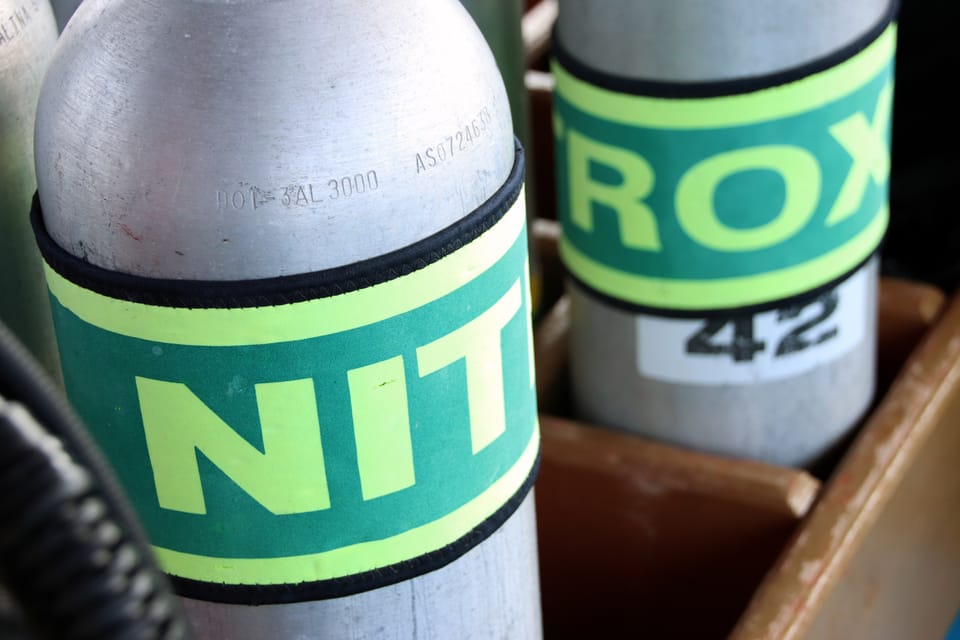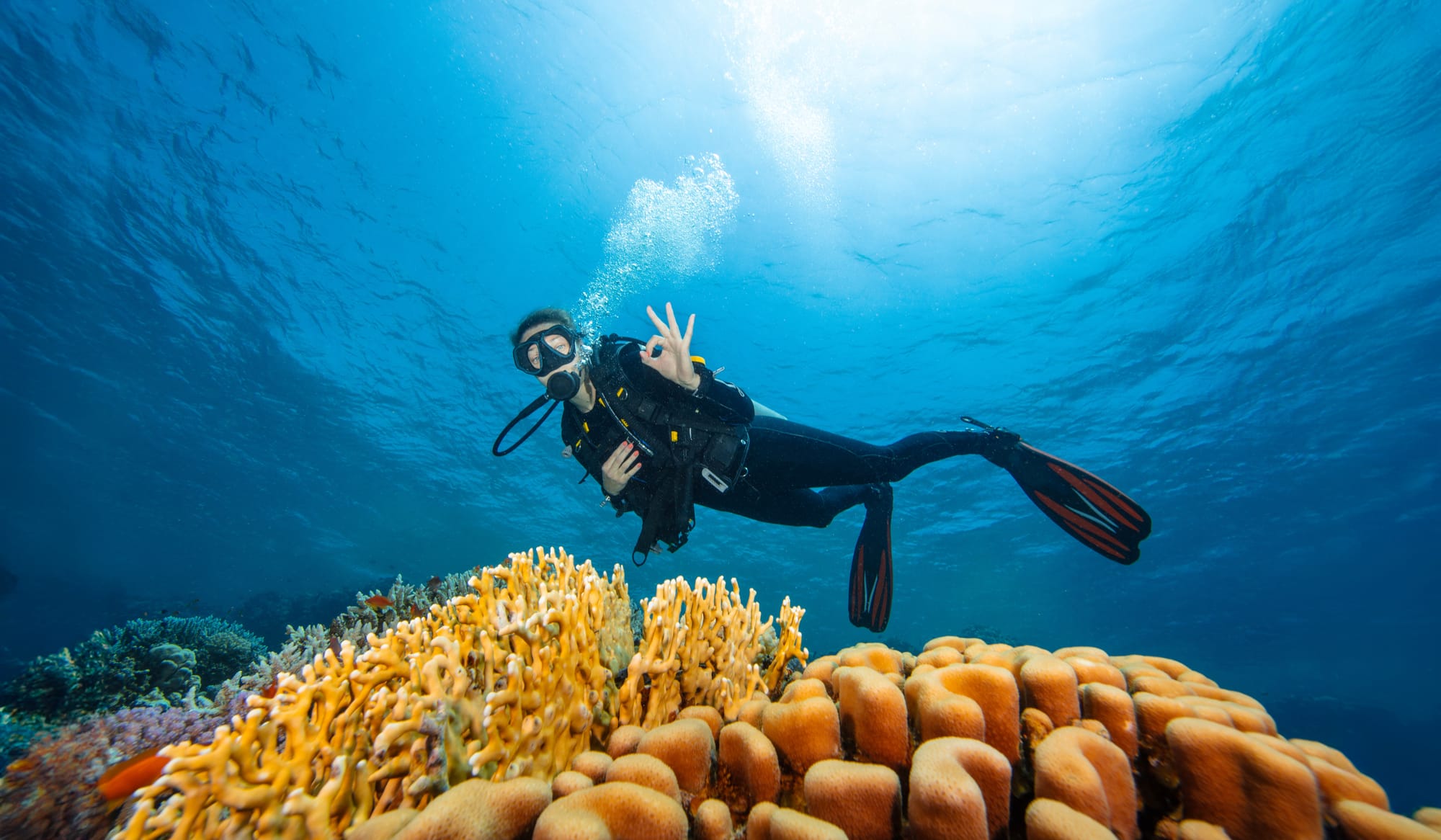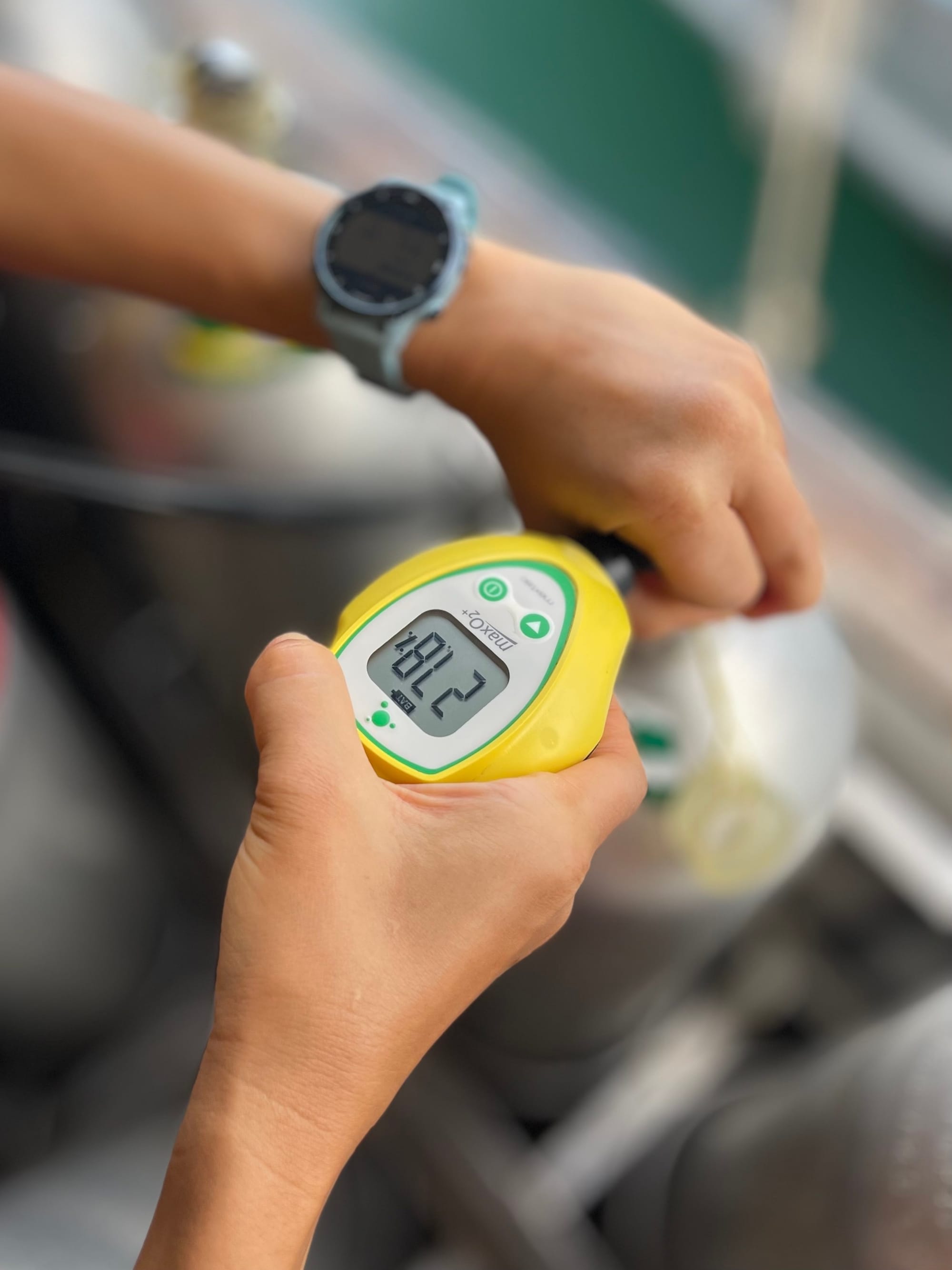Diving with Nitrox: Tables, Calculations, and all there is to know

Introduction to Nitrox
Nitrox (Which stands for Nitrogen and Oxygen), also referred to as EAN (Enriched Air Nitrox), designates a gas blend of Nitrogen and Oxygen where the Oxygen concentration is greater than 21%. Put more simply, it is a gas blend that is richer in Oxygen than air.
Because there is a whole range of possible blends for a nitrox mix (An oxygen concentration of 21%, 22%, 23%, ... up to 100%) we label a blend EANx, x being the oxygen concentration. For example, if we were talking about using "EAN36", this would mean that the blend we are breathing is composed of 36% oxygen (and by extension, 64% Nitrogen).
It is common for dive centers to mark nitrox tanks with the distinctive colors yellow/green, but more on that later!
Benefits of using Nitrox
Using Nitrox has its pros and cons, but let's start with the positive first and understand why it is so popular as a breathing gas.
Increased Bottom time
As Nitrox blends have an increased proportion of oxygen in the mixture (also called oxygen fraction, designating what percentage of the gas mix is made up by oxygen), the nitrogen part (also called nitrogen fraction, designating the same thing for nitrogen) decreases. Consequently, we limit our nitrogen exposure compared to regular air, and the nitrogen on-gassing is slower: what this means is that you can stay at a certain depth for longer than if you were using air, because nitrogen is saturating your tissues at a slower rate.
There is a useful tool divers use to compare the nitrogen exposure of a certain nitrox blend compared to air: the EAD, or Equivalent Air Depth.
To calculate the EAD in both metric and imperial:
\( EAD(m) = ((Depth + 10) \cdot ({F_{N2} \over 0.79}))-10 \) \( EAD(ft) = ((Depth + 33) \cdot ({F_{N2} \over 0.79}))-33 \) \( F_{N2} \text{ being the nitrogen fraction (value between 0 and 1)}\)For instance, if we breathe a nitrox blend of 36% (FN2 = 0.64) at 28m of depth, we would calculate the EAD to be approximately 20.8 meters, meaning that we on-gas at the same rate at 28 meters using EAN36 as we do at 20.8 meters using air.
Reduced risk of DCS
As the exposure to nitrogen is reduced, it is possible to follow a dive profile on air while using nitrox (respecting the restricted depth, which I will talk about in a bit) to be more conservative towards no-decompression limits. Intuitively, we can think about the fact that nitrox allows for longer bottom time, but if we follow the shorter bottom time dictated by a plan using air, it would add an extra layer of safety and further reduce the likelihood of DCS.
Of course, if we stay longer at the bottom (following the nitrox plan), the dissolved nitrogen in the tissues will be the same
However, at shallower depths, the off-gassing is more efficient due to the reduced nitrogen content in the breathing gas.
Consecutive dives
Reduced shallow on-gassing means that the residual nitrogen will be lower for consecutive multi-level dives. This means, in a recreational setting, the chances of DCS onset will be reduced.
Especially during a multi-day diving trip, the use of nitrox is recommended!

Limits and dangers of Nitrox
With all of those positive points, there are some limitations with Nitrox, especially regarding the higher oxygen fraction.
Oxygen toxicity
We need oxygen to live, but as it turns out, too much of anything is bad for you! This is true for Oxygen as well. It is a very reactive compound, and at higher partial pressure, exposure to Oxygen can be harmful.
Since there is more Oxygen in Nitrox than in air, this is an issue that needs to be discussed here!
Oxygen toxicity exists and manifests itself in two forms, depending on whether it is a short-term or long-term exposure:
The short term exposure occurs at high partial pressures and will harm the central nervous sytem. For this reason, it is refered to as CNS oxygen toxicity. Divers prevent CNS oxygen toxicity by not breathing oxygen at a partial pressure greater than 1.4 recreationnaly and 1.6 during decompression stops.
The long-term exposure can occur at both high and low partial pressure, and if the PPO2 is constant over multiple days, it can start at as low as 0.5 bar (generally more of a concern in the health sector). The long-term oxygen toxicity can appear in two different forms: pulmonary and ocular (affecting the lungs and the retina, respectively). Divers prevent pulmonary oxygen toxicity and ocular oxygen toxicity by tracking the exposure to oxygen over the course of multiple dives/multiple days.
In practice, for recreational divers, CNS toxicity will be a bigger issue to keep track of, as to surpass the long-term exposure safe limit, you would need to be doing intense dives multiple times per day, every day for multiple weeks. But nevertheless, let's have an in-depth look at how to limit the effect of oxygen toxicity in practice.
Depth Limit
One of the first thing you learn when you start diving on nitrox, is that although your bottom time increases (i.e. you can stay at a certain depth longer), your maximum depth decreases (i.e. you cannot go as deep as you would on air). This is because -as previously mentioned-, we are trying to limit our oxygen partial pressure (referred to as PPO2) to 1.4 bar or lower.
To calculate the PPO2, the formula is:
PPO2 = Ambient pressure × Oxygen fraction
The deeper we go, the more the ambient pressure increases and the more the PPO2 increases. For instance, if we were breathing air on the surface, we would be subjected to 1 atm of pressure, our PPO2 would be 1 atm × 0.21 = 0.21 atm.
Now, if we were going to a depth of 30m (still breathing air), our PPO2 would be 4atm×0.21=0.84 atm.
Naturally, using Nitrox, the PPO2 reaches 1.4 faster than if we were using air because the oxygen fraction is greater: By comparison, if we were using EAN30 at 30 meters, we would be subjected to a PPO2 of 4 atm × 0.30 = 1.2 atm.
To make sure divers don't accidentally go too deep with the wrong gas, we introduce the concept of MOD, which stands for Maximum Operating Depth. The MOD of a certain gas mix is defined as the depth where breathing the gas would subject the diver to a PPO2 of 1.4 atm. To calculate the MOD of a gas, we use the following formula:
MOD (m) = (PPO2/FO2)×10 - 10
MOD (ft) = (PPO2/FO2)×33 - 33
For example, we could calculate the Maximum Operating Depth of Air (FO2 = 0.21 and PPO2 = 1.4): (1.4/0.21)×10-10 = 56.7m
Here is a table with common gas mix and their associated Maximum Operating Depth in meters and feet:
| Mix | MOD |
|---|---|
| Air | 57m/187ft |
| EAN28 | 40m/132ft |
| EAN32 | 34m/111ft |
| EAN36 | 29m/95ft |
Analyzing and Marking a Nitrox tank
To track nitrogen and oxygen exposure, it is understandably important to make sure you are breathing the proper mix, and for that, it is crucial to analyze and mark your tank properly.
A good instructor/dive guide will either let you analyze your own tank while supervising, or make sure you have an eye on the analyzer while he/she is analyzing the tank. It is very important that each diver sees the analyzer’s result for themselves.

An oxygen analyzer (sometimes also called a nitrox analyzer) is a tool used to measure the oxygen fraction of a gas. It usually has a tip designed to fit the valve opening of scuba tanks. The oxygen sensor inside the analyzer can uncalibrate itself over time; for this reason, analyzers should always be recalibrated before use. Usually, you would use an air tank to calibrate it and make sure the analyzer shows an oxygen content of 20.9-21.0%
Once you have analyzed your Nitrox tank, mark it clearly! What exactly needs to be on the marking may change between dive centers, but there is always:
- The MOD of the Nitrox mix
- The oxygen fraction of the mix
- The name of the diver who is going to use the tank
CNS Oxygen Clock and OTUs
Limiting the depth while using certain Nitrox blends is a great tool against short-term-high-intensity oxygen exposure. However, as mentioned before, we still have to deal with the long-term exposure (meaning consecutive dives over multiple days). For that, divers measure their exposure using Oxygen Toxicity Units, or OTU for short. We keep track of how many OTUs our body "stores" and make sure it stays under a certain limit. 1 OTU is defined as breathing 100% O2 at 1 atmosphere for 1 minute, but the amount of OTU/min varies with the PPO2 we are exposed to. The National Oceanic and Atmospheric Administration created the following tables to track and manage our OTU level:
| PPO2 (atm) | OTU/min |
|---|---|
| 0.5 | 0 |
| 0.55 | 0.15 |
| 0.60 | 0.27 |
| 0.65 | 0.37 |
| 0.70 | 0.47 |
| 0.75 | 0.56 |
| 0.80 | 0.65 |
| 0.85 | 0.74 |
| 0.90 | 0.83 |
| 0.95 | 0.92 |
| 1.00 | 1.00 |
| 1.05 | 1.08 |
| 1.10 | 1.16 |
| 1.15 | 1.24 |
| 1.20 | 1.32 |
| 1.25 | 1.40 |
| 1.30 | 1.48 |
| 1.35 | 1.55 |
| 1.40 | 1.63 |
| 1.45 | 1.70 |
| 1.50 | 1.78 |
| 1.55 | 1.85 |
| 1.60 | 1.92 |
| 1.65 | 2.00 |
| 1.70 | 2.07 |
| 1.75 | 2.14 |
| 1.80 | 2.21 |
| 1.85 | 2.28 |
| 1.90 | 2.35 |
| 1.95 | 2.42 |
| 2.00 | 2.49 |
Then, using the following table to limit the OTU levels for consecutive dives/multiple days:
| Exposure day | Max daily OTU | Max total OTU over duration |
|---|---|---|
| 1 | 850 | 850 |
| 2 | 700 | 1400 |
| 3 | 620 | 1860 |
| 4 | 525 | 2100 |
| 5 | 460 | 2300 |
| 6 | 420 | 2520 |
| 7 | 380 | 2660 |
| 8 | 350 | 2800 |
| 9 | 330 | 2970 |
| 10 | 310 | 3100 |
| 11+ | 300 | 3300 (+300 per day) |
How to recognize Oxygen toxicity
Of course, as divers, we try to limit Oxygen toxicity cases, but it is still important to recognise it if it happens to you or your buddy
CNS oxygen toxicity
There are multiple signs and symptoms associated with CNS oxygen toxicity, such as:
- Visual changes, such as tunnel vision
- Ear ringing
- Becoming irritable
- Twitching
- Nausea
If early signs and symptoms aren't recognized, it may progress to a seizure (clonic-tonic seizure). During the Clonic phase, the diver will be subjected to muscle contraction/paralysis, while during the Tonic phase, the diver will alternate between muscle spasms and relaxation, before falling unconscious during the final (postictal) state. If a diver has seizures underwater, he will not be able to help himself and will need help from a buddy to ascend to reduce the PPO2 and exit the water promptly.
Pulmonary oxygen toxicity
Although late pulmonary oxygen toxicity can be quite serious, it begins with small symptoms, including:
- Airway irritation
- Coughing
- Chest tickling
- Shortness of breath
In practice, pulmonary toxicity stems from an inflammation and shares similar symptoms. If the exposure to oxygen over time is not reduced, it may lead to pulmonary edema, decreased pulmonary function, and hypoaxemia (low oxygen level in the blood). This can be fatal or leave permanent damage.
FAQs
Q: Can I go deeper with Nitrox?
A: Nitrox allows you to stay longer at a certain depth, but does not allow you to go deeper. As a matter of fact, you are more limited in depth using Nitrox.
Q: What Nitrox should I use at 25m?
A: The optimal Nitrox mix at 25m is the mix that will have a PPO2 of 1.4 at 25m, we can calculate it rearranging the MOD formula:
EAN mix = (10×1.4)/(MOD+10)
For 25m, we have (10×1.4)/(25+10)=0.4, or 40%. This means that the best mix for 25m is EAN40.
Q: Is Nitrox good on Wrecks?
A: Nitrox is especially good for wrecks, as it will give you more time to explore the wreck!
Is Nitrox dangerous?
A: Nitrox is not particularly dangerous, although there are some additional dangers associated with it, divers take all the necessary precautions to deal with it, on top of the safety margins being quite large (meaning, even if a diver were to exceed the MOD for a little bit, he would be fine, although it is not an excuse to do it!).
